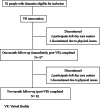Exploring the Immediate and Long-Term Effects of Immersive Virtual Reality on Behavioral and Psychological Symptoms of Dementia and Caregiver Burden: Longitudinal Observational Study
- PMID: 40669069
- PMCID: PMC12286566
- DOI: 10.2196/73044
Exploring the Immediate and Long-Term Effects of Immersive Virtual Reality on Behavioral and Psychological Symptoms of Dementia and Caregiver Burden: Longitudinal Observational Study
Abstract
Background: Virtual reality (VR) interventions are emerging as promising nonpharmacological strategies for people with dementia, aiming to prevent cognitive decline, reduce behavioral and psychological symptoms of dementia (BPSD), and alleviate caregiver burden. Although some studies have reported beneficial effects, findings remain inconsistent, and little is known about the duration and sustainability of these effects, particularly in real-world care settings.
Objective: This study aimed to examine both the immediate and long-term effects of an immersive VR reminiscence intervention on BPSD and caregiver burden in people with dementia attending day care centers.
Methods: This longitudinal observational study was conducted in 10 dementia day care centers in Kaohsiung, Taiwan. A total of 82 participants with dementia were enrolled. The VR intervention consisted of twice-weekly sessions over one month, featuring culturally familiar live-action 360° scenes filmed in well-known Taiwanese locations. Each session lasted approximately 10-12 minutes and included interactive elements. Neuropsychiatric symptoms were assessed using the Neuropsychiatric Inventory Questionnaire, and caregiver burden was assessed using the Zarit Caregiver Burden Interview. Measurements were taken at 3 time points: preintervention, immediately postintervention, and 2 months after the intervention ended. The Wilcoxon signed-rank test was used for statistical comparisons, and rank-biserial correlation was calculated as the effect size.
Results: Significant improvements were observed after 1 month of VR intervention in both caregiver burden (Z=-3.095, P=.002, r=0.34) and neuropsychiatric symptoms (Z=-2.929, P=.003, r=0.32). At the two-month follow-up, neuropsychiatric symptoms remained significantly improved (Z=-4.327, P<.001, r=0.48), although caregiver burden returned to preintervention levels. Regarding specific neuropsychiatric symptoms, significant improvements were observed immediately after the intervention in dysphoria or depression, anxiety, and sleep or nighttime behaviors. These effects were sustained over time, with additional long-term improvements noted in euphoria or elation, apathy or indifference, irritability or lability, aberrant motor behavior, and appetite or eating behaviors.
Conclusions: A 1-month immersive VR reminiscence intervention appears to improve neuropsychiatric symptoms and temporarily reduce caregiver burden in people with dementia, with some symptom improvements lasting up to 2 months. These findings suggest that VR may offer a meaningful therapeutic option in day care settings. Future studies with control groups, including nonimmersive 2D conditions, and comparisons to traditional reminiscence therapy are needed to validate and expand upon these findings.
Keywords: behavioral and psychological symptoms of dementia; caregiver burden; dementia; long-term effects; virtual reality.
© Ling-Chun Huang, Ching-Fang Chien, Yuan-Han Yang. Originally published in JMIR Serious Games (https://games.jmir.org).
Conflict of interest statement
Figures
Similar articles
-
Effects of a Reminiscence Therapy Program on Neuropsychiatric Symptoms and Quality of Life in People With Dementia: A Pilot Study Comparing Immersive Virtual Reality and Non-immersive Approaches.Dementia (London). 2025 Aug 7:14713012251366348. doi: 10.1177/14713012251366348. Online ahead of print. Dementia (London). 2025. PMID: 40772956
-
Reminiscence therapy for dementia.Cochrane Database Syst Rev. 2018 Mar 1;3(3):CD001120. doi: 10.1002/14651858.CD001120.pub3. Cochrane Database Syst Rev. 2018. PMID: 29493789 Free PMC article.
-
The Black Book of Psychotropic Dosing and Monitoring.Psychopharmacol Bull. 2024 Jul 8;54(3):8-59. Psychopharmacol Bull. 2024. PMID: 38993656 Free PMC article. Review.
-
Psychological treatments for depression and anxiety in dementia and mild cognitive impairment.Cochrane Database Syst Rev. 2022 Apr 25;4(4):CD009125. doi: 10.1002/14651858.CD009125.pub3. Cochrane Database Syst Rev. 2022. PMID: 35466396 Free PMC article.
-
Exercise programs for people with dementia.Cochrane Database Syst Rev. 2015 Apr 15;2015(4):CD006489. doi: 10.1002/14651858.CD006489.pub4. Cochrane Database Syst Rev. 2015. PMID: 25874613 Free PMC article.
References
-
- GBD 2019 Dementia Forecasting Collaborators Estimation of the global prevalence of dementia in 2019 and forecasted prevalence in 2050: an analysis for the Global Burden of Disease Study 2019. Lancet Public Health. 2022 Feb;7(2):e105–e125. doi: 10.1016/S2468-2667(21)00249-8. doi. Medline. - DOI - PMC - PubMed
LinkOut - more resources
Full Text Sources



